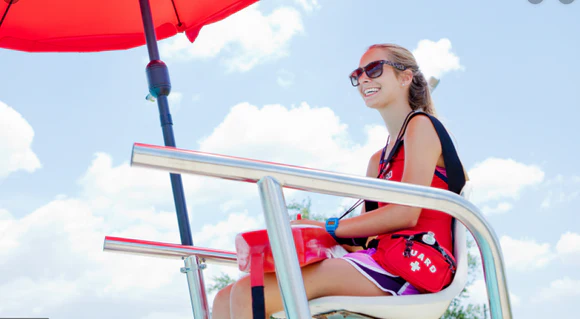
Become a Certified Lifesaver with Lifeguard Training
- American Lifeguard Association
- Health
- 2025-07-26 15:24:19
- 1122K
American lifeguard training help prepare individuals with the critical skills and knowledge needed to save lives in aquatic environments. Whether you’re planning to work at a community pool, a beachfront, or a waterpark, completing a lifeguard course is the first step to a rewarding and impactful career. Offered both online and onsite, American Lifeguard’s program is a nationally recognized certification pathway, ideal for aspiring lifeguards who value flexibility, professionalism, and high-quality instruction.
Why Lifeguard Training is Essential
Lifeguarding isn’t just about sitting in a chair with a whistle—it’s a high-responsibility role that demands fast thinking, strength, and strong training in emergency response. The lifeguard training course offered by American Lifeguard equips you with:
Water rescue techniques
CPR and first aid training for lifeguards
AED (automated external defibrillator) skills
Spinal injury management
Legal responsibilities and professional ethics
By completing this program, candidates become capable of managing both minor incidents and life-threatening emergencies, ensuring the safety of swimmers and sunbathers alike.
Course Overview: Online & Onsite Flexibility
American Lifeguard offers both online video-based lifeguard training and in-person options, making it accessible for all types of learners.
Online Lifeguard Course (27 Hours)
Perfect for those who need flexibility, the lifeguard course online format spans 27 hours of comprehensive video content. Candidates can learn at their own pace and schedule, making it an ideal choice for students or working professionals.
Topics include:
Water rescue fundamentals
Victim recognition and response
CPR/First Aid for aquatic settings
Lifeguard skills assessments via video submissions
Onsite Training Option
Prefer hands-on experience? American Lifeguard also provides lifeguard training for pools and beaches with certified instructors guiding you through physical rescues, group drills, and live simulations.
How to Become a Certified Lifeguard
Taking the first step toward a lifeguard career requires completing a reputable and nationally recognized certification program. Here’s how the process works:
Enroll in the American Lifeguard training course (online or onsite)
Complete all modules, including CPR and First Aid
Pass the written and physical skills exams
Receive your American Lifeguard certification
Apply to lifeguard positions across pools, beaches, or aquatic parks
American Lifeguard ensures your credentials meet industry standards, often fulfilling requirements equal to or exceeding those of the Red Cross lifeguard certification.
Who Should Take This Lifeguard Course?
This course is ideal for:
High school and college students seeking part-time work
Swim instructors looking to upskill
Fitness or recreation staff at gyms or resorts
Individuals passionate about water safety and helping others
The course is open to anyone aged 15 or older with basic swimming proficiency.
Lifeguard Skills You’ll Gain
The American Lifeguard training program goes far beyond textbook learning. Here’s what you’ll walk away with:
Rescue Readiness: Recognize and respond to distressed swimmers within 30 seconds
Emergency Response: Deliver effective CPR and use AEDs confidently
Prevention Techniques: Learn how to prevent incidents before they occur
Professionalism: Understand the legal and ethical responsibilities of a certified lifeguard
These skills are tested and honed through realistic training scenarios, instructor feedback, and skill assessment modules.
Benefits of Becoming a Lifeguard
Pursuing a lifeguard certification doesn’t just lead to a summer job—it opens doors to a range of benefits, including:
Physical Fitness
The job keeps you active and fit, building stamina, strength, and alertness.
Life-Saving Knowledge
You’ll gain lifesaving knowledge applicable beyond the workplace, benefiting family, friends, and your community.
Employment Opportunities
Lifeguards are in constant demand—especially in summer months. Many employers prioritize certified lifeguards over non-certified candidates.
Income Potential
Part-time and full-time opportunities are available, often with competitive hourly rates and flexible schedules.
Career Advancement
With experience, certified lifeguards can transition into roles such as head lifeguard, pool manager, or aquatic safety trainer.
Comparing American Lifeguard to Red Cross Lifeguard Certification
While both programs are widely respected, American Lifeguard offers advantages such as:
Online learning flexibility
Nationwide onsite programs
Faster certification timeframes
Competitive pricing
Both certifications are widely accepted by employers, but American Lifeguard is often preferred for its hybrid model and comprehensive video-based learning.
Lifeguard Certification Course Near Me: How to Get Started
Searching for a “lifeguard certification course near me”? The American Lifeguard website allows you to browse local onsite training options by ZIP code. Simply:
Visit [Insert Website URL]
Select your preferred learning mode: Online or Onsite
Choose a date/location
Register and begin your training
Support is available throughout the course to ensure success—whether you’re struggling with skills videos or need help scheduling an in-person test.
Lifeguard Course FAQs
Is the American Lifeguard certification recognized nationally?
Yes, the certification is accepted by most aquatic facilities across the United States.
Can I get certified fully online?
Yes, the 27-hour lifeguard course online allows full certification via video-based modules and assessments, though some employers may still require in-person testing.
How long is the certification valid?
Certifications are typically valid for two years, after which a recertification course is required.
Conclusion: Start Your Lifesaving Journey Today
Lifeguard training with American Lifeguard is more than a course—it’s a commitment to safety, professionalism, and making a real difference. Whether you choose the flexible online option or prefer hands-on, in-person instruction, this course empowers you with the skills and certification to save lives and build a meaningful career.
Leave a Reply
Please login to post a comment.












0 Comments